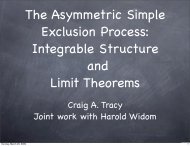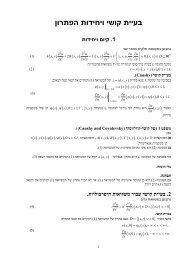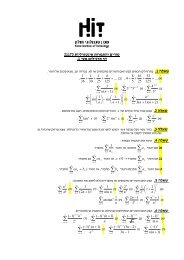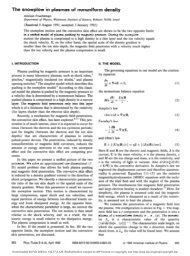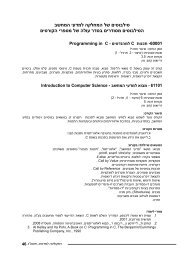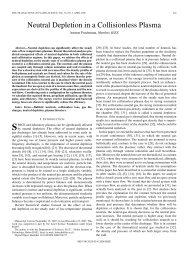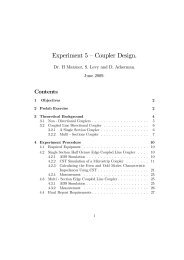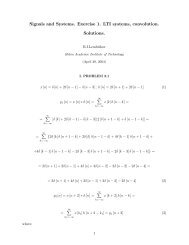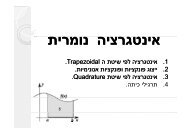Solution of Exam on Ordinary Differential Equations. Trial Aleph ...
Solution of Exam on Ordinary Differential Equations. Trial Aleph ...
Solution of Exam on Ordinary Differential Equations. Trial Aleph ...
Create successful ePaper yourself
Turn your PDF publications into a flip-book with our unique Google optimized e-Paper software.
<str<strong>on</strong>g>Soluti<strong>on</strong></str<strong>on</strong>g> <str<strong>on</strong>g>of</str<strong>on</strong>g> <str<strong>on</strong>g>Exam</str<strong>on</strong>g> <strong>on</strong> <strong>Ordinary</strong><br />
Di¤erential Equati<strong>on</strong>s.<br />
<strong>Trial</strong> <strong>Aleph</strong><br />
19.01.2005, 9:00-12:00<br />
January 26, 2005<br />
1 Problem 1<br />
1.1 <str<strong>on</strong>g>Soluti<strong>on</strong></str<strong>on</strong>g><br />
3x 2 y 00 + 8xy 0 2y = 0 (1)<br />
x 0 = 0<br />
Here P 1 (x) = 8<br />
3x<br />
) x 2 0 = 0 is a singular point; P 2 (x) = 2<br />
3x<br />
; 2<br />
xP 1 (x) = 8 3 ; x2 P 2 (x) = 2<br />
3 ) x 0 = 0 is a singular regular point;<br />
p 1 (0) = 8 3 ; p 2 (0) = 2<br />
3 ; 2 +(p 1 (0) 1) +p 2 (0) = 2 + 8 3<br />
1 <br />
+ 2<br />
3 =<br />
2 + 5 3 2<br />
3 :<br />
The indicial equati<strong>on</strong> is:<br />
3 2 + 5 2 = 0 (2)<br />
1 = 1 3 ; 2 = 2; 1 2 = 5 3 =2 Z: 1
0<br />
X 1<br />
y (x) = x a n x n ; a 0 6= 0; jxj < 1 (3)<br />
n=0<br />
X<br />
1<br />
y 0 (x) = x (n + ) a n x n 1 ;<br />
n=0<br />
X<br />
1<br />
xy 0 (x) = x (n + ) a n x n ; (4)<br />
n=0<br />
X<br />
1<br />
y 00 (x) = x (n + ) (n + 1) a n x n 2 ;<br />
n=0<br />
X<br />
1<br />
x 2 y 00 (x) = x (n + ) (n + 1) a n x n ; (5)<br />
n=0<br />
3x 2 y 00 + 8xy 0 2y =<br />
= 3 (x P 1<br />
n=0 (n + ) (n + 1) a nx n )+8 (x P 1<br />
n=0 (n + ) a nx n ) 2x P 1<br />
n=0 a nx n =<br />
x P 1<br />
n=0 (3 (n + ) (n + 1) + 8 (n + ) 2) a nx n = 0<br />
1X<br />
(3 (n + ) (n + 1) + 8 (n + ) 2) a n x n = 0; jxj < +1 (6)<br />
n=0<br />
(3 ( 1) + 8 2) a 0 = 0; a 0 6= 0 , 3 2 + 8 2 = 0 , 2 + 5 3 2<br />
3 = 0 (7)<br />
(3 (n + ) (n + 1) + 8 (n + ) 2) a n = 0; n = 1; 2; :::;<br />
= 1 ; = 2 : 3 (n + ) (n + 1) + 8 (n + ) 2 6= 0; n = 1; 2; :::; ,<br />
3<br />
, a n = 0; n = 1; 2; :::: (8)<br />
= 1 = 1 3 :<br />
y 1 (x) = x 1<br />
P 1<br />
n=0 a nx n = 3p x a 0 + a 1 x + a 2 x 2 + ::: = a 0<br />
3 p x; 8a 0 2 R; a 0 6=<br />
0 ) a 0 = 1<br />
y 1 (x) = 3p x (9)<br />
= 1 = 2 :<br />
y 2 (x) = x P<br />
2 1<br />
n=0 a nx n = x 2 a 0 + a 1 x + a 2 x 2 + ::: 1<br />
= a 0 x<br />
; 8a 2 0 2 R; a 0 6=<br />
0 ) a 0 = 1<br />
y 1 (x) = 1 x 2 (10)<br />
2
1.2 Answer<br />
y (x) = C 1<br />
3 p x + C 2<br />
1<br />
x 2 ; 8C 1; C 2 2 R; (11)<br />
2 Problem 2<br />
y 00 + y = 1<br />
cos x<br />
(12)<br />
2.1 <str<strong>on</strong>g>Soluti<strong>on</strong></str<strong>on</strong>g><br />
2.1.1 <str<strong>on</strong>g>Soluti<strong>on</strong></str<strong>on</strong>g> <str<strong>on</strong>g>of</str<strong>on</strong>g> homogeneous equati<strong>on</strong><br />
, Exact soluti<strong>on</strong> is: C 1 cos x + C 2 sin x;<br />
2.1.2 Variati<strong>on</strong> <str<strong>on</strong>g>of</str<strong>on</strong>g> parameters<br />
C 1<br />
def<br />
= C 1 (x) ; C 2<br />
def<br />
= C 2 (x)<br />
y 00 + y = 0 (13)<br />
y 1 (x) = cos x; y 2 (x) = sin x (14)<br />
, <str<strong>on</strong>g>Soluti<strong>on</strong></str<strong>on</strong>g> is: [C 0 1 = tan x; C 0 2 = 1]<br />
C1 0 cos x + C2 0 sin x = 0 (15)<br />
C1 0 sin x + C2 0 cos x =<br />
1<br />
cos x<br />
(16)<br />
Z<br />
C1 0 (x) = tan x , C 1 (x) = tan xdx = ln jcos xj + C 1 (17)<br />
Z<br />
C2 0 (x) = 1 , C 2 (x) = dx = x + C 2 (18)<br />
2.2 Answer<br />
y (x) = (ln jcos xj + C 1 ) cos x + (x + C 2 ) sin x<br />
y (x) = (ln jcos xj) cos x + x sin x + C 1 cos x + C 2 sin x (19)<br />
3 Problem 3-aleph<br />
y 0 =<br />
2xy + y2<br />
x 2 (20)<br />
3
3.1 <str<strong>on</strong>g>Soluti<strong>on</strong></str<strong>on</strong>g><br />
2xy+y 2<br />
x<br />
= 2xy<br />
2 x<br />
+ y2<br />
2 x<br />
= 2 y 2 x +<br />
y 2<br />
x<br />
, y<br />
0<br />
= 2 y <br />
x +<br />
y 2<br />
x<br />
;so equati<strong>on</strong> (20) is<br />
homogeneous equati<strong>on</strong>.<br />
y<br />
x = z , y = zx; y0 = z 0 x + z; z 0 x + z = 2z + z 2 ; z 0 x = z + z 2 ;<br />
dz<br />
z+z<br />
= dx; R dz<br />
2 z+z 2<br />
1<br />
z+z<br />
= 1 2 z<br />
ln <br />
z<br />
(z+1)x<br />
z = y x )<br />
= R dx<br />
x ;<br />
1<br />
z+1 )R dz<br />
z+z<br />
= R 1<br />
2 z<br />
= C; <br />
z<br />
(z+1)x<br />
z<br />
z+1 = y x<br />
y<br />
x +1 =<br />
dz<br />
dx x = z + z2 (21)<br />
<br />
1<br />
z+1<br />
dz = ln jzj<br />
<br />
ln jz + 1j = ln<br />
z<br />
z+1<br />
ln<br />
z<br />
z + 1 = ln jxj + C (22)<br />
= e c = jCj<br />
y<br />
x+y ;<br />
z<br />
(z + 1) x = C<br />
z<br />
(z+1)x =<br />
y<br />
(x+y)x ;<br />
y<br />
(x + y) x = C<br />
y = Cx (x + y) = Cxy + Cx 2 ; y Cxy = Cx 2 ; y (1 Cx) = Cx 2<br />
y (1) = 1 : 1 y<br />
2<br />
= ln 1 + C = C;<br />
y =<br />
Cx2<br />
1 Cx<br />
(x+y)x = 1 2 () y =<br />
x2 = 2x2<br />
1 1 2 x 2 x<br />
<br />
3.2 Answer<br />
y<br />
(x + y) x = 1 2x2<br />
() y =<br />
2 2 x<br />
(23)<br />
4 Problem 3-bet<br />
4.1 <str<strong>on</strong>g>Soluti<strong>on</strong></str<strong>on</strong>g>.<br />
Equati<strong>on</strong> (24) is an equati<strong>on</strong> <str<strong>on</strong>g>of</str<strong>on</strong>g> the form<br />
where p (x) = 1; q (x) = e x ; m = 3:<br />
y (x) = 0 is a soluti<strong>on</strong> (partial or singular?)<br />
Now assume y 6= 0:<br />
y 0 + y = e x y 3 (24)<br />
y 0 + p (x) y = q (x) y m ; (25)<br />
4
4.1.1 General soluti<strong>on</strong>. The …rst way<br />
y 0 + y = e x y 3 , y0<br />
y<br />
+ 1 3 y<br />
= e x<br />
2<br />
z = 1<br />
y<br />
) z 0 = 2y0<br />
2 y<br />
, y0<br />
3 y<br />
= 1 3 2 z0<br />
1<br />
2 z0 + z = e x , z 0 2z = 2e x<br />
z 0 2z = 2e x (26)<br />
Ce<br />
z = e 2x C 2 R e 2x e x dx = e 2x C 2 R e x dx = Ce 2x + 2e 2x e x =<br />
2x + 2e x z = Ce 2x + 2e x (27)<br />
z = 1<br />
y 2 , 1<br />
y 2 = Ce 2x + 2e x , y 2 =<br />
1<br />
Ce 2x +2e x<br />
y 2 =<br />
1<br />
Ce 2x + 2e x ; C 2 R (28)<br />
lim y (x) = lim p 1<br />
C!1 C!1 Ce<br />
= 0;so y (x) = 0 is a partial soluti<strong>on</strong>.<br />
2x +2e x<br />
1<br />
y (x) = p<br />
Ce<br />
2x<br />
+ 2e ; C 2 R<br />
x<br />
4.1.2 General soluti<strong>on</strong>. The sec<strong>on</strong>d way<br />
y (x) = u (x) v (x) ; y 0 = u 0 v + uv 0 ; u 0 v + uv 0 ; y 0 + y = u 0 v + uv 0 + uv = e x u 3 v 3<br />
u 0 v + u (v 0 + v) = e x u 3 v 3<br />
v 0 + v = 0 ) v = e x<br />
u 0 v = e x u 3 v 3 ; y 6= 0 ) v 6= 0 , u 0 = e x u 3 v 2 = e x u 3 e 2x = u 3 e x<br />
du<br />
dx = u3 e x ; du<br />
u<br />
1<br />
3<br />
C;<br />
e x +C = 2u2 ;<br />
u 0 = u 3 e x<br />
= e x dx; R du<br />
u 3 = R e x dx;<br />
1<br />
2u 2 = e x + C;<br />
1<br />
2u 2 = e x +<br />
u 2 =<br />
1<br />
2(e x +C) ; y2 = u 2 v 2 = u 2 e 2x =<br />
1<br />
2e 2x (e x +C) = 1<br />
2e x +Ce 2x ;<br />
y =<br />
1<br />
p<br />
2ex + Ce 2x<br />
4.1.3 Partial soluti<strong>on</strong> satisfying given initial c<strong>on</strong>diti<strong>on</strong>s<br />
y (0) = 1 2 : 1 4 = 1<br />
C+2 ; C + 2 = 4; C = 2<br />
y (x) =<br />
1<br />
p<br />
2 (e<br />
2x<br />
+ e x )<br />
5
4.2 Answer<br />
y (x) =<br />
1<br />
p<br />
2 (e<br />
2x<br />
+ e x )<br />
(29)<br />
5 Problem 4<br />
y 00 2y 0 + 2y = e x cos x (30)<br />
5.1 <str<strong>on</strong>g>Soluti<strong>on</strong></str<strong>on</strong>g><br />
5.1.1 <str<strong>on</strong>g>Soluti<strong>on</strong></str<strong>on</strong>g> <str<strong>on</strong>g>of</str<strong>on</strong>g> homogeneous equati<strong>on</strong><br />
y 00 2y 0 + 2y = 0 (31)<br />
, <str<strong>on</strong>g>Soluti<strong>on</strong></str<strong>on</strong>g> is: 1 i; 1 + i<br />
2 2 + 2 = 0 (32)<br />
5.1.2 First way(C<strong>on</strong>jecture Method)<br />
y = e x (C 1 cos x + C 2 sin x) (33)<br />
e x cos x = Re e (1+i)x ; = 1 + i is a root <str<strong>on</strong>g>of</str<strong>on</strong>g> the characteristic equati<strong>on</strong> (32) <str<strong>on</strong>g>of</str<strong>on</strong>g><br />
multiplicity 1, so the partial soluti<strong>on</strong> <str<strong>on</strong>g>of</str<strong>on</strong>g> equati<strong>on</strong> (30) is obtained by c<strong>on</strong>jecture<br />
y p (x) = xe x (A cos x + B sin x) (34)<br />
y 0 p (x) = d<br />
dx (xex (A cos x + B sin x)) =<br />
= A (cos x) e x + B (sin x) e x + Ax (cos x) e x + Bx (cos x) e x Ax (sin x) e x +<br />
Bx (sin x) e x =<br />
= Ae x cos x + Be x sin x + (A + B) xe x cos x + ( A + B) x sin x<br />
y 0 p (x) = e x (A cos x + B sin x + (A + B) x cos x + ( A + B) x sin x) (35)<br />
y 00<br />
p (x) = d2<br />
dx 2 (xe x (A cos x + B sin x)) =<br />
= d<br />
dx (ex (A cos x + B sin x + (A + B) x cos x + ( A + B) x sin x)) =<br />
= 2A (cos x) e x +2B (cos x) e x 2A (sin x) e x +2B (sin x) e x +2Bx (cos x) e x<br />
2Ax (sin x) e x =<br />
= (2A + 2B) e x cos x + (2B 2A) e x sin x + 2Bxe x cos x 2Axe x sin x<br />
y 00<br />
p (x) = 2e x ((A + B) cos x + (B A) sin x + Bx cos x Ax sin x) (36)<br />
y 00<br />
p 2y 0 p + 2y p =<br />
= 2e x ((A + B) cos x + (B A) sin x + Bx cos x Ax sin x)<br />
6
2e x ((A cos x + B sin x + (A + B) x cos x + ( A + B) x sin x)) +<br />
+2e x (Ax cos x + Bx sin x) = e x cos x<br />
2 ((A + B) cos x + (B A) sin x + Bx cos x Ax sin x)<br />
2 ((A cos x + B sin x + (A + B) x cos x + ( A + B) x sin x)) +<br />
+2 (Ax cos x + Bx sin x) = cos x<br />
((A + B) cos x + (B A) sin x + Bx cos x Ax sin x)<br />
((A cos x + B sin x + (A + B) x cos x + ( A + B) x sin x)) +<br />
+ (Ax cos x + Bx sin x) = 1 2 cos x<br />
0<br />
A + B A 1 2<br />
cos x + (B A B) sin x + (B A B + A) x cos x + ( A + A B + B) x sin x<br />
<br />
=<br />
<br />
cos x A sin x<br />
<br />
= 0<br />
A = 0; B = 1 2<br />
B 1 2<br />
(37)<br />
y p (x) = 1 2 ex sin x (38)<br />
y (x) = 1 2 xex sin x + e x (C 1 cos x + C 2 sin x) ; C 1 ; C 2 2 R (39)<br />
5.1.3 Sec<strong>on</strong>d way(Variati<strong>on</strong> <str<strong>on</strong>g>of</str<strong>on</strong>g> Parameters Method)<br />
C 1<br />
def<br />
def<br />
= C 1 (x) ; C 2 = C 2 (x)<br />
y 1 (x) = e x cos x; y1 0 (x) = d<br />
dx (ex cos x) = e x (cos x sin x)<br />
y 2 (x) = e x sin x; y2 0 (x) = d<br />
dx (ex sin x) = e x (cos x + sin x)<br />
C 0 1e x cos x + C 0 2e x sin x = 0 (40)<br />
C 0 1e x (cos x sin x) + C 0 2e x (cos x + sin x) = e x cos x (41)<br />
C 0 1 cos x + C 0 2 sin x = 0 (42)<br />
C 0 1 (cos x sin x) + C 0 2 (cos x + sin x) = cos x (43)<br />
C1 0 = sin x cos x; C2 0 = cos 2 x<br />
C 1 (x) = R sin x cos xdx = 1 4 cos 2x 1<br />
4 + C 1;<br />
C 2 (x) = R cos 2 xdx = 1 2 x + 1 4 sin 2x + C 2<br />
y (x) = 1 4 cos 2x 1<br />
4 + C 1<br />
e x cos x + 1 2 x + 1 4 sin 2x + C 2<br />
e x sin x =<br />
= 1 4 ex (cos 2x cos x + sin 2x sin x)+e x 1<br />
C 1 4<br />
cos x + C2 sin x + 1 2 xex sin x 1 =<br />
= 1 4 ex cos x+e x 1<br />
C 1 4<br />
cos x + C2 sin x + 1 2 xex sin x = 1 2 xex sin x+e x (C 1 cos x + C 2 sin x)<br />
1 cos 2x cos x + sin 2x sin x = cos (2x x) = cos x<br />
7
5.2 Answer<br />
y (x) = 1 2 xex sin x + e x (C 1 cos x + C 2 sin x) ; C 1 ; C 2 2 R (44)<br />
6 Problem 5<br />
_x =<br />
_y =<br />
cos 2 x<br />
tan y tan x<br />
cos 2 y<br />
tan y tan x<br />
(45)<br />
(46)<br />
6.1 <str<strong>on</strong>g>Soluti<strong>on</strong></str<strong>on</strong>g><br />
_y<br />
_x = y0 x =<br />
cos2 y<br />
tan y tan x<br />
cos 2 x<br />
tan y tan x<br />
dy<br />
dx = cos2 y<br />
cos 2 x ;<br />
dy<br />
cos 2 y =<br />
= cos2 y<br />
cos 2 x ;<br />
dx<br />
cos 2 x ; R<br />
y 0 = cos2 y<br />
cos 2 x<br />
dy<br />
cos 2 y = R<br />
dx<br />
cos 2 x ; tan y = tan x + C 1;<br />
(47)<br />
cos 2 x<br />
tan y tan x = cos2 x<br />
C 1<br />
;<br />
tan y tan x = C 1<br />
cos 2 y<br />
tan y tan x = cos2 y<br />
C 1<br />
_x = cos2 x<br />
C<br />
_y = cos2 y<br />
C<br />
dx<br />
dt = cos2 x<br />
C ; dx<br />
cos 2 x = dt<br />
C ; R dx<br />
cos 2 x = R dt<br />
C ; tan x = 1 C t+C 1; x = arctan 1 C t + C 1<br />
:<br />
dy<br />
dt = cos2 y<br />
C ; dy<br />
cos 2 y = dt<br />
C ; R dy<br />
cos 2 y = R dt<br />
C ; tan y = 1 C t+C 2; y = arctan 1 C t + C 2<br />
:<br />
tan y tan x = C , 1 C t + C <br />
1<br />
2 C t + C 1<br />
= C2 C 1 = C<br />
6.2 Answer<br />
<br />
<br />
1<br />
x (t) = arctan t + C 1<br />
C 2 C 1<br />
<br />
<br />
1<br />
y (t) = arctan t + C 2<br />
C 2 C 1<br />
8C 1 ; C 2 2 R; C 1 6= C 2 :<br />
8
7 Problem 6<br />
y 0 = 1<br />
x<br />
y<br />
7.1 <str<strong>on</strong>g>Soluti<strong>on</strong></str<strong>on</strong>g>. First way<br />
x y = z; 1 y 0 = z 0 ; y 0 = 1 z 0 ; 1 z 0 = 1 z ; z0 1<br />
= 1<br />
dz<br />
dx = z 1<br />
z<br />
; dz<br />
z 1 = dx; zdz<br />
z 1 = dx; R zdz<br />
z 1<br />
z<br />
x y ln jx y 1j = x + C , y + ln jx y 1j = C<br />
z = z 1<br />
z ;<br />
= dx; z + ln jz 1j = x + C;<br />
7.2 <strong>Aleph</strong>.<br />
7.2.1 Answer<br />
y + ln jx y 1j = C; C 2 R<br />
7.3 Bet<br />
y (3) = 0 :<br />
0 + ln (3 0 1) = ln 2 = C<br />
7.3.1 Answer<br />
ln<br />
jx y 1j<br />
2<br />
= y (48)<br />
7.4 <str<strong>on</strong>g>Soluti<strong>on</strong></str<strong>on</strong>g>. Sec<strong>on</strong>d way<br />
y 0 = dy<br />
dx = 1<br />
x<br />
y , dx<br />
dy = x 0 = x y (49)<br />
Equati<strong>on</strong> (49) is a linear n<strong>on</strong>homogeneous equati<strong>on</strong> <str<strong>on</strong>g>of</str<strong>on</strong>g> the …rst order.<br />
7.4.1 <strong>Aleph</strong><br />
x = e y C<br />
Z<br />
<br />
e y ydy = e y C e y e y ye y = e y C + y + 1<br />
7.4.2 Answer<br />
7.4.3 Bet<br />
x = e y C + y + 1 (50)<br />
y (3) = 0 , x (0) = 3 :<br />
3 = C + 1; C = 2<br />
9
7.4.4 Answer<br />
x = 2e y + y + 1<br />
8 Problem 7<br />
8.1 <str<strong>on</strong>g>Soluti<strong>on</strong></str<strong>on</strong>g><br />
x 2 2x + 3 y 00 + (2x + 1) y 0 + y = 0 (51)<br />
y (1) = y 0 (1) = 1<br />
x 0 = 1 ) x 2 0 2x 0 + 3 = 1 2 + 3 = 2 6= 0 ) x 0 = 1 is a regular point.<br />
x 1 = t , x = t + 1; z (t) def<br />
= y (t + 1) , y (x) = z (x 1) ; y 0 = z 0 ; y 00 = z 00<br />
x 2 2x + 3 y 00 +(2x + 1) y 0 +y =<br />
z =<br />
= t 2 + 2 z 00 + (2t + 3) z 0 + z<br />
<br />
<br />
(t + 1) 2 2 (t + 1) + 3 z 00 +(2 (t + 1) + 1) z 0 +<br />
t 0 = 0 is a regular point.<br />
t 2 + 2 z 00 + (2t + 3) z 0 + z = 0 (52)<br />
z (0) = z 0 (0) = 1<br />
z =<br />
z 0 =<br />
tz 0 =<br />
z 00 =<br />
t 2 z 00 =<br />
1X<br />
a n t n (53)<br />
n=0<br />
1X<br />
1X<br />
na n t n 1 = (n + 1) a n+1 t n (54)<br />
n=0<br />
n=0<br />
1X<br />
na n t n (55)<br />
n=0<br />
1X<br />
1X<br />
n (n 1) a n t n 2 = (n + 2) (n + 1) a n+2 t n (56)<br />
n=0<br />
n=0<br />
1X<br />
n (n 1) a n t n (57)<br />
n=0<br />
t 2 + 2 z 00 + (2t + 3) z 0 + z = t 2 z 00 + 2z 00 + 2tz 0 + 3z 0 + z = 0<br />
P 1<br />
n=0 n (n 1) a nt n + P 1<br />
n=0 2 (n + 2) (n + 1) a n+2t n + P 1<br />
n=0 2na nt n + P 1<br />
P n=0 3 (n + 1) a n+1t n +<br />
1<br />
n=0 a nt n = 0<br />
10
P 1<br />
n=0 (n (n 1) a n + 2 (n + 2) (n + 1) a n+2 + 2na n + 3 (n + 1) a n+1 + a n ) t n =<br />
0<br />
P 1<br />
n=0 (2 (n + 2) (n + 1) a n+2 + 3 (n + 1) a n+1 + (n (n 1) + 2n + 1) a n ) t n =<br />
0<br />
2 (n + 2) (n + 1) a n+2 +3 (n + 1) a n+1 +(n (n 1) + 2n + 1) a n = 0; n = 0; 1; 2; :::<br />
(58)<br />
a n+2 =<br />
3<br />
2 (n + 2) a n+1<br />
n 2 + n + 1<br />
2 (n + 2) (n + 1) a n; n = 0; 1; 2; ::: (59)<br />
z (0) = a 0 = 1; z 0 (0) = a 1 = 1<br />
n = 0 :<br />
a 2 = 3 4 a 1<br />
1 4 a 0 = 1<br />
n = 1 :<br />
a 3 = 3 6 a 2<br />
n = 2 :<br />
a 4 = 3 8 a 3<br />
3<br />
12 a 1 = 1 2 ( 1) 1<br />
4 = 1 4<br />
7<br />
24 a 2 = 3 8 1 4<br />
7<br />
19<br />
24<br />
( 1) =<br />
96<br />
n = 3 :<br />
a 5 =<br />
3<br />
2(3+2) a 4<br />
9+3+1<br />
2(3+2)(3+1) a 3 = 3<br />
10<br />
<br />
19<br />
96<br />
13<br />
40 1 4 = 9<br />
64<br />
n = 4 :<br />
::::::::::::::::::::::::::::::::::::::::::::::::::::::::::::::<br />
z (t) = a 0 +a 1 t+a 2 t 2 +a 3 t 3 +a 4 t 4 +a 5 t 5 +::: = 1+t t 2 + 1 4 t3 + 19<br />
y (x) = z (x 1)<br />
8.2 Answer<br />
96 t4 9<br />
64 t5 +:::;<br />
y (x) = 1 + (x 1) (x 1) 2 + 1 4 (x 1)3 + 19<br />
96 (x 1)4 9<br />
64 (x 1)5 + :::<br />
11




